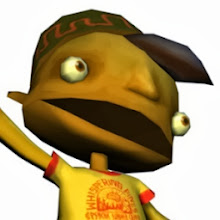 As good of a platform as the Game Boy Advance was, one would never make the mistake of calling it a hotbed of innovation. Look at the best titles available on the platform - a lot of SNES ports (the Super Mario Advance series, the Final Fantasy Advance series) , and remakes (Metroid: Zero Mission, River City Ransom EX). Even what completely original titles there were tended to be genre exercises - none of the Castlevania titles strayed very far from the Symphony of the Night tree, nor did Metroid Fusion stray far from Super Metroid. Mario & Luigi, while offering some innovative battle mechanics wasn't all that different than say Paper Mario or similar reductivist RPGs.
As good of a platform as the Game Boy Advance was, one would never make the mistake of calling it a hotbed of innovation. Look at the best titles available on the platform - a lot of SNES ports (the Super Mario Advance series, the Final Fantasy Advance series) , and remakes (Metroid: Zero Mission, River City Ransom EX). Even what completely original titles there were tended to be genre exercises - none of the Castlevania titles strayed very far from the Symphony of the Night tree, nor did Metroid Fusion stray far from Super Metroid. Mario & Luigi, while offering some innovative battle mechanics wasn't all that different than say Paper Mario or similar reductivist RPGs.All of this makes Wario Ware all the more noteable. It isn't even that novel of a concept when you think about it. Mini-game collections had been around - most noteably in anthology-type sports titles - and the idea of a 'micro-game' was simply an extension of this. Wario Ware's brilliance, however, lied in the way these games were tied together - each game following the other with only a brief pause in between. The challenge came as much in keeping track of what was going on as it did in actually completing any of the tasks presented, the tasks usually coming down to a single timed button press.
Also remarkable is that somehow, for all its sequels, none has quite matched the frantic pace of the original (well, Twisted did, but I can make a better point if I ignore this for now). Touched somehow managed to feel outright slow - especially early in rounds before things sped up, while Smooth Moves was bogged down by the need to change controller positions between every game. The original succeeded by establishing early on that your control would never extend beyond the d-pad and the 'a' button. From here it was able to jump off to add entries from nearly every genre imaginable. It didn't even matter if any of these micro-games was actually any good, the game was never about them but rather about the game built around them. if a single title didn't work, it hardly mattered - it would be over in a second, and considering its entire raison d'etre was to serve as an obstacle for the game built around it, it's just as well if it doesn't quite work.
All of this is further aided by the wonderful amount of charm on display. Granted, the Wario Ware art-style frequently veers into the grotesque, but it still imbues the proceedings with a feeling of energy and liveliness that would be missed otherwise. The sound design (even on the woefully sub-par GBA sound hardware) is a marvel along these same lines, doing an excellent job at heightening tension while remaining all over the map and eclectic.
Mega Microgames simply managed to be leaner than any of its sucessors (and any of its later imitators). While it may be a shame that the Wario Ware series has caught a bit of the Katamari syndrome - a fresh idea or premise that gets diluted each successive time out, perhaps better called Wario Ware syndrome since Wario Ware did it first (of course M. Night Shyamalan did it before either of them) none of this detracts from Wario Ware's status as one of the most innovative titles of the last decade.
WarioWare, Inc.: Mega Microgame$!
Publisher: Nintendo
Developer: Nintendo R&D 1
Released: 5/21/2003
Obtained: Around Christmas 2003 (Giftcard)
Publisher: Nintendo
Developer: Nintendo R&D 1
Released: 5/21/2003
Obtained: Around Christmas 2003 (Giftcard)
9.0/10


No comments:
Post a Comment